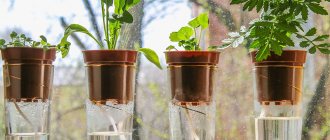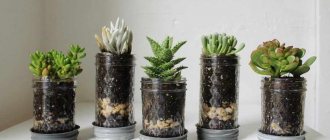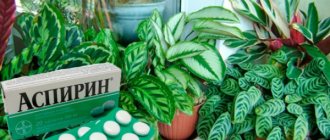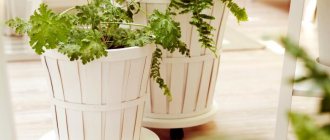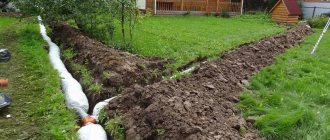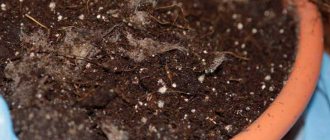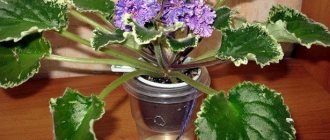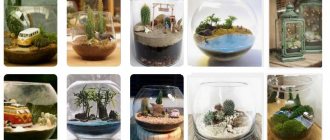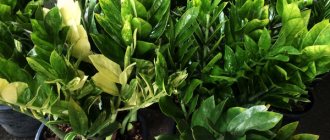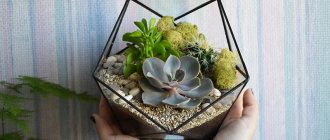Drainage is a system that maintains an optimal level of moisture in the soil by removing excess moisture. In practice, it is a layer of coarse material that is located at the bottom of the container with the plant. This system is necessary for all indoor flowers and decorative foliage crops, as well as seedlings, without exception. When growing them at home without a drainage layer, you may encounter a number of problems and difficulties in caring for them. Why is it important to have a drainage layer in a container with a plant and how to do it correctly?
What is drainage for indoor plants?
For normal functioning of the root system, indoor plants require soil containing about 50% volume of solid particles, 35% moisture and 15% voids filled with air. These conditions can be ensured only by creating a drainage layer from coarse material.
The absence of air in the soil is favorable conditions for the proliferation of fungi and bacteria, causing rotting of the roots and subsequent oppression of the plant.
Another function of drainage is to ensure rapid drainage of excess water during irrigation. This condition is especially important for plants that cannot tolerate excess moisture.
What can be used as drainage at home?
Any coarse material that is chemically neutral, resistant to rotting and destruction, and does not compact over time is suitable for soil drainage.
The following materials have these characteristics:
- natural origin - pebbles and crushed stone;
- specially prepared sterilized expanded clay of the same fraction, vermiculite or perlite;
- improvised materials - pieces of brick, fragments of ceramics and polystyrene foam.
All of the listed materials differ in thermal conductivity, which affects the temperature of the plant root system, the ability to absorb water, and also have other advantages and disadvantages depending on the physical and chemical properties.
Expanded clay for flowers
Expanded clay is a thermally treated clay with a porous structure. Its main purpose is to insulate and soundproof the walls of buildings during construction.
Expanded clay used for drainage first undergoes fractional screening, washed and disinfected. Calibration is also carried out for small, medium and large fractions.
Due to its porosity, expanded clay absorbs excess moisture well and also has high thermal insulation properties, maintaining an optimal temperature for the roots. Within approximately 6 years, this material deteriorates and must be replaced.
Attention! The chemical neutrality of expanded clay is disputed by some florists who claim that it increases soil acidity. However, this material is the most common option for creating a drainage layer.
Ceramic shards
You can use broken ceramic shards to drain the soil. It also has a porous structure, which allows it to accumulate moisture and gradually release it into the ground, preventing the soil from completely drying out. The density of ceramics is higher than that of expanded clay, which results in a longer service life compared to the latter.
The sharp edges of the ceramics must be dulled to prevent mechanical damage to the ends of the plants. Ceramic shards are placed on the bottom of the planting container with the concave side down. Additionally, it is better to sprinkle the top layer of ceramics with expanded clay.
Perlite and vermiculite
Perlite and vermiculite have higher drainage properties. Therefore, these materials are the most expensive.
Perlite is a processed volcanic rock. It is a porous gray or white granule.
Vermiculite is a calcined layered mineral from the hydromica group. During the heating process, the layers are divided into flakes that form pores.
Both perlite and vermiculite are able to absorb water and then return moisture when the soil dries out, and also have excellent thermal insulation properties.
Sphagnum moss
Some florists use sphagnum moss as a drainage layer. It, like a sponge, absorbs a large amount of moisture, preventing the soil in the flower pot from drying out.
Sphagnum is quite rare on sale, but you can prepare it yourself. It is advisable to do this in the autumn, since at this time it is easier to keep the moss in proper condition during transportation. Before use, it is soaked in warm water to saturate it with moisture and remove insects.
Sphagnum moss is stored in a cool place in packaging that provides air access to it. It is also possible to freeze this raw material, since the properties of moss are not lost when defrosted.
Charcoal
Charcoal is well suited for soil drainage, performing the functions of a natural fertilizer and antiseptic, not only preventing putrefactive processes, but also adsorbing salts and regulating the soil moisture saturation.
Like many, charcoal drainage for flowers perfectly absorbs and retains liquid and minerals until the moment when the soil dries out and needs moisture. Charcoal is a neutral, porous, inert and lightweight material.
For drainage, it is laid out on the bottom of the flowerpot in a layer of 2 cm. It is advisable to take large fractions or those that will not pass through the drainage holes of the pot.
What else can replace drainage? Available means
If it is not possible to purchase industrial-made drainage, you can use improvised materials instead. Suitable for this:
- crushed stone;
- broken brick;
- Styrofoam;
- river stones.
In some respects, the above materials are inferior to industrial ones, however, they are successfully used by florists.
Attention! Use of available raw materials as drainage should be done with caution, because in this way pathogens of fungal and bacterial diseases can be introduced into the soil.
Charcoal
In addition to the function of removing and absorbing excess moisture, charcoal enriches the soil with minerals and disinfects it, preventing rotting, and absorbs salts. It is lightweight and does not affect the weight of flower pots.
Charcoal is placed on the bottom of the planting container in a layer of about 2 cm, and only the coarse fraction is used.
Crushed stone, gravel, river stone
These materials are publicly available, but you need to independently calibrate them in size, filter out debris and pre-rinse them in water. Their disadvantage is their high specific gravity and high thermal conductivity. Therefore, they cause hypothermia of the roots of indoor flowers at low temperatures or overheating when placing pots on window sills above radiators. To improve thermal insulation, it is necessary to lay a layer of expanded clay, perlite or other porous material on top of crushed stone or gravel.
Broken brick
The properties of broken brick are similar to fragments of ceramics. Before using it as drainage, the sharp edges are blunted to prevent damage to the roots. After this procedure, it is washed from dust and debris.
Broken brick is used for plants that store moisture in leaves and stems and are able to do without holes in the bottom of the planting container.
Styrofoam
Polystyrene foam is a lightweight porous material. Moreover, it is public. It removes excess moisture without absorbing water, therefore it is inferior in quality to perlite and expanded clay. However, due to its thermal insulation properties, polystyrene foam maintains the necessary temperature for plant roots.
Attention! It is better to create a drainage layer from polystyrene foam for those indoor plants that require frequent replanting or have an underdeveloped root system. Over time, the roots of the plant grow into the foam, after which it is impossible to free them without mechanical damage.
Ceramic shards
If expanded clay is not on sale, then the question arises of what can replace drainage for flowers. For these purposes, a material such as ceramics will serve perfectly.
To create this type of drainage, you need to place large shards with the convex side up or several small pieces on the holes in the pot. Then, if the container is small, pour a one and a half centimeter layer of purified coarse sand, and a five centimeter layer if it is large. A layer of earth is poured on top and the plant is planted.
The disadvantage of this material is the danger of damaging the roots with sharp sides. You should not use shards that are too large, as sand will spill through them.
How to make a drainage layer correctly?
It is better to either completely renew the drainage when replanting plants, or thoroughly rinse it of soil particles when reusing it. The thickness of the drainage layer depends on the type of indoor plant, the height of the pot, and the number and diameter of holes in the bottom of the container.
How to determine how thick the layer should be:
- with a small number of holes in the bottom of the flower pot, a high layer of drainage material is required - up to 1/4 of the height of the pot;
- if the number of drainage holes is larger, it is necessary to make a middle layer of drainage material - 1/5 of the height of the flower pot;
- for pots with a large number of large-diameter holes, a low drainage layer is suitable - 1/6 of the height of the planting container.
Drainage with high thermal conductivity (crushed stone, pebbles, river stones) must be covered with a layer of porous materials - expanded clay, vermiculite or perlite. The size of the drainage material should be smaller in diameter than the holes in the bottom of the flower pot and cover the bottom evenly.
Pot.
You've probably noticed that the vast majority of pots are conical in shape. This is necessary so that the soil in the depths dries out better. A large number of holes (especially large ones) not only improve the drainage of excess water, but also help improve air saturation. All this prevents soil oxidation, which means it works to improve the drainage system.
A flowerpot is a flowerpot without holes. They are used as an outer decorative shell for ugly technical pots (with holes). It is better to use flowerpots for their intended purpose (that is, do not plant plants in them), since planting a flower in it will make it more difficult to organize the water balance in the root zone, especially for a novice gardener.
I would like to write separately about ceramic pots, because almost all sources indicate their exceptional usefulness in terms of regulating water balance. It is very important not to get confused here. Glazed ceramics are just for beauty. There is nothing beneficial for plants in them. It is more difficult to organize the water balance in such a pot. Only unglazed ceramics without the use of paint are useful for plants. Most often, the store will indicate the material - terracotta, i.e. clay without gloss or patterns.
Mistakes when making your own
Florists make the following mistakes when making drainage:
- Using sand, which compacts and does not allow moisture to pass through.
- The fraction of drainage material is over 3 cm, which does not retain moisture.
- The use of organic materials that rot over time.
- Use of chemically unstable materials.
- Laying drainage with sharp edges that damage the roots of indoor plants.
The healthy appearance of the plant, growth and development depend on the condition of the soil and drainage layer. Properly laid drainage will provide the required humidity for a particular type of indoor plant.
5/5 — (2 votes)
Surface drainage: types of lines and installation locations
A surface network of drainage lines and rainwater collection points is organized in areas, regardless of the type and composition of the soil, and relief features. Without a drainage system, moisture will stagnate in all natural depressions after rains. After the snow melts, water flows erode the paths and the top layer of soil. If you plan to lay a decorative covering, be sure to install several drainage branches underneath it - the yard will remain level and the tiles will not fall through.
Options for organizing surface trenches:
- Installation of ready-made trays. Plastic, polymer concrete, concrete containers with decorative lids are installed where it is undesirable to leave open channels: in the yard, on areas where there is traffic.
Ready-made trays in the drainage system
- Backfilled lines. Without concrete mortar or purchasing expensive materials, you can also make full-fledged drainage branches. Backfill materials allow moisture to pass deep into the soil, while simultaneously retaining dirt, silt, and debris. Decorated with multi-colored bedding (painted expanded clay, minerals, colored crushed stone), the channels become part of the landscape design. Fill lines are installed in open ground, where there is no risk of damage to the drainage by equipment: in the garden, on the lawn, in the vegetable garden.
Open channel with backfill
- Closed branches. Covered surface drainage lines are installed followed by covering the backfill with a layer of soil and turf. Such trenches are invisible on the surface.
Drainage ring in deep systems
In areas located on loams that poorly absorb moisture from the surface, or soils with a consistently high groundwater level that needs to be artificially lowered, deep drainage is installed.
Installation of ring drainage around the house
It is imperative to install branches around a residential building if the base of the foundation is above the groundwater level, so that the basement does not flood and the foundation walls are not destroyed by water. A drainage clip is placed in the trenches: a special perforated pipe in expanded clay (gravel, crushed stone) sprinkling and geotextile wrapping.
Diagram: drainage clip
It is advisable to install deep expanded clay drainage in the garden: reducing the water level in the soil will have a beneficial effect on the condition of the roots of fruit trees and ornamental plants. The system is formed in the form of branches connected at an angle of 45° to the main line, along which water is discharged to the “receiver” - a pond, a ditch, a drainage well.
Crushed stone or expanded clay: choice of material
To arrange drainage use:
- Geotextiles. Synthetic fabric with micropores. The holes allow moisture to pass freely, but retain solid particles. The fabric protects the drainage cage from silting, filters water coming from above, and in the lower part prevents the system from becoming clogged with eroded soil and sand from the bottom.
Options for arranging drains in geotextiles: with and without pipes
- Sand. Placed on the bottom of the channel. The sand cushion is a mandatory element, the base on which drainage layers are formed. Sand conducts moisture well and creates a barrier between the soil and the canvas.
- Perforated pipes. The optimal choice (especially for deep systems) is special corrugated hoses with factory perforation. Flexibility and ease of installation are the main advantages of drainage pipes. Economy options: you can make your own drainage pipe from a regular sewer pipe by drilling holes with a diameter of 2–4 mm in increments of 2–5 cm along the entire length and circumference. Instead of pipes, to improve outflow, use plastic bottles (without bottom or neck) laid in sprinkles; old tires, cut into 6 - 8 segments; bundles of vines or branches.
- Crushed stone or expanded clay. The size of the fraction used to form drainage backfills is medium and large. Fine backfill material is not used: too small particles clog the holes in the drainage pipe.
The backfill that is placed in the trenches must be clean: if gravel or crushed stone is used, you need to buy washed, or sift and wash the material yourself several times. Lime and dust under the influence of moisture will turn into a thick mass, gluing crushed stone and clogging the holes of fabric and pipes.
Different fractions of expanded clay
Expanded clay drainage is environmentally friendly. The main advantages of the material: lightness and low cost. When choosing backfill for drainage trenches, pay attention to the shape: expanded clay gravel - oval, smooth; crushed stone - in the form of squares, polygons. Expanded clay crushed stone particles with sharp corners and an uneven surface have the best drainage properties. Fraction – 20 – 40 mm.
The coarse fraction is used for filling in drainage networks
Another advantage of expanded clay is its low thermal conductivity; the material is used as thermal insulation in construction. Even pipes laid close to the ground surface, sprinkled with such crushed stone, will not freeze in winter.
